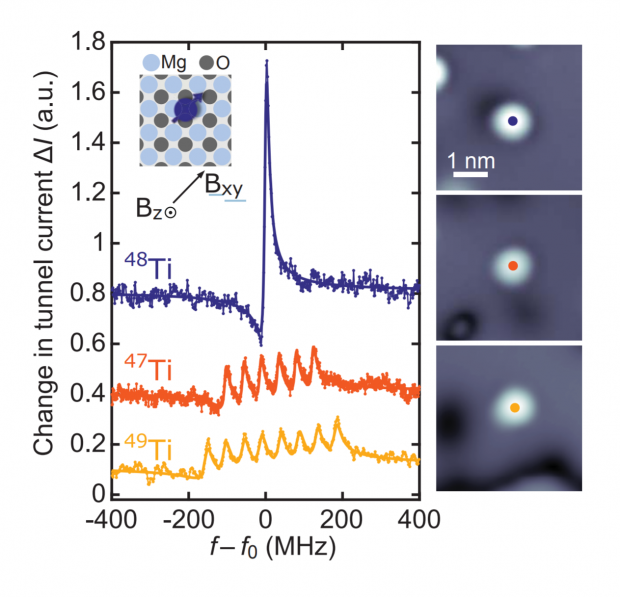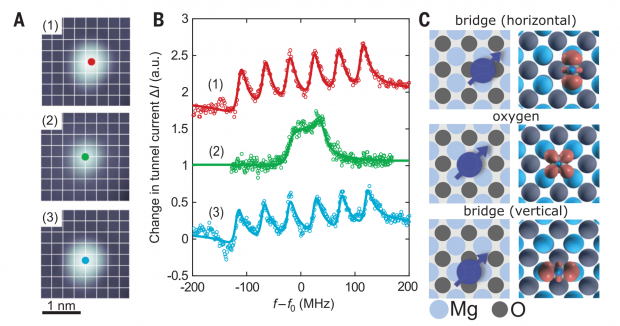본문
Hyperfine Interaction of Single Atoms on a Surface
By Prof. Andreas J. Heinrich (heinrich@ewha.ac.kr)
Department of Physics
Director of Center for Quantum Nanoscience, Institute for Basic Science
Nuclear spins are a versatile tool for medical imaging, chemical structure analysis and recently as a platform for quantum computing (1). Normally the nuclear spin can only be measured in very large numbers, but detection and control of single nuclear spins is possible for e.g. molecules in break junctions (2) or defects in solids (3). Nevertheless, up to now, no experimental tool allowed imaging of the atomic-scale environment of the nucleus and simultaneously detecting the presence of the nuclear spin.
In this research, we detected the nuclear spin of individual atoms on surfaces for the first time. To do so we used a scanning tunneling microscope, which consists of an atomically sharp metal tip and allows us to image and probe single atoms. The two elements that were investigated in this work, iron and titanium, are atoms that can have a different number of neutrons in the atom’s core, these are the so-called isotopes. Only certain isotopes of each element have a core with a nuclear spin. It is normally exceedingly hard to measure nuclear spins of individual atoms.
In order to detect the presence of a nuclear spin within the core of a single atom, we measured the hyperfine interaction, which describes the coupling between a single atom’s nuclear spin and its electron counterpart, that is generally much easier to access. It changes for different isotopes due to a different number of nuclear spin states (Figure 1). We found that the hyperfine interaction of an atom changed when we moved it to a different position on the surface (Figure 2) or if we moved other atoms next to it. In both cases, the electronic structure of the atom changes and the nuclear spin allows us to detect that.
Consequently, we plan to use this sensitivity of the hyperfine interaction within the chemical environment as a quantum sensor. Nuclear spins are already used for biological imaging in MRI machines in hospitals. Similarly, in our experiment the nuclear spin allows us to measure properties of the electronic structure of atoms and molecules that would otherwise remain hidden. Next, we want to store information in the atom’s nuclear spin and we also plans to use their technique to test pathways for quantum computation.

Figure 1. Hyperfine interaction for titanium. ESR spectra for 48Ti(blue, nuclear spin I=0, same spectrum as for 46Ti and 50Ti), 47Ti(orange, I=5/2) and 49Ti(yellow, I=7/2). Inset: binding site of the atom. Right panel: STM images for each atom

Figure 2. Binding site dependence of the hyperfine spectrum of titanium. (A) Using atom manipulation, a 47Ti atom on a bridge site of the underlying MgO lattice was moved to an oxygen binding site(TiO) and subsequently to a different bridge binding site. White lines indicate the MgO lattice with the intercepts corresponding to the positions of oxygen atoms.
(B) ESR spectra for the binding sites in (A) (C) Sketches (left) show the binding site. Calculated spin density (right) of the binding configurations obtained by Density functional theory.
* Related Article
Philip Willke, Yujeong Bae, Kai Yang, Jose L. Lado, Alejandro Ferrón, Taeyoung Choi, Arzhang Ardavan, Joaquín Fernández-Rossier, Andreas J. Heinrich, and Christopher P. Lutz. Hyperfine interaction of individual atoms on a surface, Science 362, no. 6412 (2018): 336-339.
B. E. Kane, A silicon-based nuclear spin quantum computer, Nature 393, 133–137 (1998).
S. Thiele et al., Electrically driven nuclear spin resonance in single-molecule magnets, Science 344, 1135–1138 (2014).
J. J. Pla et al., High-fidelity readout and control of a nuclear spin qubit in silicon, Nature 496, 334–338 (2013).
* Video Clip
Explaining Scientific Research to Non-scientists! (Hyperfine Coupling)
Hyperfine 3D Animation














